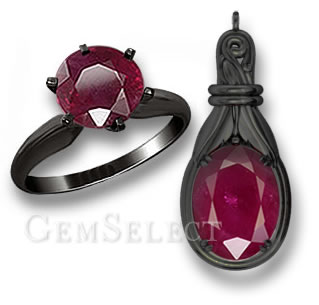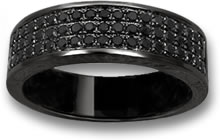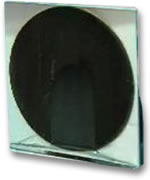|
Reviewed By Andreas Zabczyk
Scratching the Surface of Black Metal Jewelry
Black Gold Ruby Ring and Pendant
Modern innovations in jewelry making have changed the face of jewelry. Nowadays, metals for jewelry are becoming so varied that it is possible to wear almost any color metal jewelry, even multicolored titanium, which is electrolytically colored. Metals can either be plated or alloyed to create unique colors. For example, gold can be alloyed with white metals to produce white gold and rhodium plating produces a bright, white finish on jewelry. It is even possible to make blue and purple gold alloys to match colored gemstones. A recent color trend for jewelry is black metal, which has an unconventional but pleasing look. Some gemstones look particularly dramatic when set into black metal. For example, the Boucheron Ivy Emerald Tiara worn by Queen Rania of Jordan is a stunning piece of work. The emeralds are set in black gold so that the metal takes a backseat and the bright green emeralds are showcased in the wreath design. There are several ways in which black metal jewelry can be achieved. For example, a black gold alloy can be made. Black gold alloys are typically made from 25% cobalt to 75% gold, though other alloys exist. Though these are referred to as "alloys", the black color is only a surface layer. Black gold production usually involves controlling the oxidation process to produce a black surface layer that can be buffed into a glossy finish. Some of these products are more stable and durable than others; alloys which contain 15% cobalt and 10% chromium, and are electrolytically hardened are preferable for this reason. However, chromium imparts an olive-green hue, which is not to everyone's liking. 
Black Rhodium-Plated Men's Ring with Black Spinel
Another method by which black jewelry is produced is electroplating, usually with black rhodium or ruthenium. This can coat the surface of jewelry to give it a black finish. An advantage with black rhodium plating is that it can be performed on selected parts of a jewelry piece. For example, a ring set with black sapphires can be plated with black rhodium around the gemstone settings only to give the appearance of a continuous black surface, while leaving the other parts of the jewelry white or yellow. This would enhance the gemstones just as white rhodium enhances white diamonds in engagement rings, making the gemstones appear larger and brighter. Additionally, selective plating can provide a pleasing, contrasting effect. It is important to note that plating is subject to wear over time, so it cannot be expected to stay as good as new when worn for years. However, replating can easily be performed by a jeweler. When colored gemstone jewelry is replated, the stones should be removed from their settings first, since some colored gemstones are sensitive to heat. Black colored jewelry can also be made by plasma-assisted chemical vapor deposition (CVD) of amorphous carbon. The coating produced by this method is glossy, hard and more durable than plating. Like rhodium plating, CVD can be performed on various metals apart from gold. This is a process that is sometimes performed on watch straps. Gold and other jewelry metals can be subjected to patination to bring about a black surface color. Patination is a film that forms on the surface of a metal due to oxidation. Gold can be treated with oxygen and sulfur-containing compounds, such as liver of sulfur, that cause a black patina to develop. Depending on the chemical process, patination can be a thin or dense film. Patination, especially a dense layer, is generally more durable than other black jewelry. However, the finish does not tend to be glossy like plating or alloy oxidation. 
A Piece of Metal Blackened by Dr Guo's Laser
Finally, laser treatment can produce surface nanostructures which render a deep black finish on metals. This is performed by femtosecond laser, which emits extremely intense, ultrashort pulses. This discovery was made by Professor Chunlei Guo of the University of Rochester in 2006. The result is that the structure of the surface area of the metal is permanently altered, so it appears black because of increased absorption of light. This method can produce the most stable and permanent black jewelry. Apart from black metal, this exciting technology can be used to change the surface of any metal to reflect almost any color. Black jewelry is beautiful, but sometimes costly due to the sophisticated techniques employed in its production. The most affordable black jewelry is plated, but this is subject to wear and tear and will probably need to be replated after several years of use. It is important for jewelry buyers to understand how their black jewelry was made before deciding on an item, especially if it is something that will be worn every day, such as an engagement ring. For those who prefer durability, it is worth investing in patinated metal or even femtosecond laser-altered black gold. For those who like a deep black color, but are willing to have their jewelry maintained by a jeweler, black rhodium plating is a good choice. This Page in Other Languages
|
| STAY IN TOUCH | NEWSLETTER |
| *You're signing up to receive GemSelect promotional email. |
Copyright © 2005-2024 GemSelect.com all rights reserved.
Reproduction (text or graphics) without the express written consent of GemSelect.com (SETT Company Ltd.) is strictly prohibited.
2664